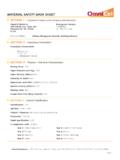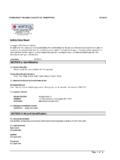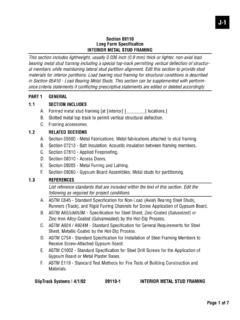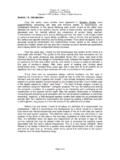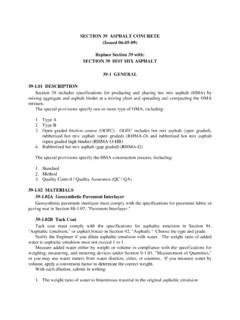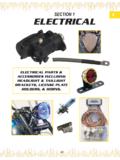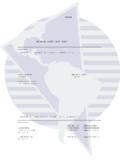Transcription of MATERIAL SAFETY DATA SHEET SECTION 1 - …
1 OmniCel Batteries 300 Schell Lane, Suite 301, Phoenixville, PA 19460 Tel Fax page 1 material safety data sheet section 1 - Chemical Product and Company Identification OmniCel Batteries Emergency Contact: 300 Schell Lane, Suite 301 CHEMTREC Phoenixville, PA 19460 Tel: 800-424-9300 PRODUCT NAME: Lithium Thionyl Chloride Battery CHEMICAL REACTION: 4Li + 2 SOCl2 4 LiCl + S + SO2 SECTION 2 - Composition, Information on Ingredients NAME Lithium (Li) OSHA PEL N/A ACGIH TLV Not established Thionyl Chloride Aluminum Chloride (AlCl3) ppm ( mg/m3) 2 mg/m3 ppm ( mg/m3) 2 mg/m3 Lithium Chloride Not established Not established SECTION 3 - Hazards Identification **DANGER** INTERNAL CONTENTS ARE EXTREMELY HAZARDOUS.
2 LEAKING FLUID IS CORROSIVE. BATTERY MAY BE EXPLOSIVE AT HIGHER TEMPERATURES. Do not expose to temperatures above temperature rating of battery due to leak hazard. If cell or battery leaks or vents Primary Routes of Entry: Inhalation Carcinogenity: Not listed by NTP, IARC, or regulated by OSHA. Health Hazards: Acute Vapors are very irritating to skin, eye, and mucous membranes. Inhalation of thionyl chloride may result in pulmonary edema. Chronic Overexposure can cause symptoms of non-fibrotic lung injury. Signs and Symptoms of Exposure: Eye and mucous membrane irritation. Medical Conditions Generally Aggravated by Exposure: Asthma, other respiratory disorders, skin allergies, and eczema.
3 SECTION 4 - First Aid Measures Eye Contact: Flush with running water for at least 15 minutes. Hold eyelids apart. Seek immediate medical attention. Contact results in acidic burns. Skin Contact: Rinse with large amounts of running water. Avoid hot water and rubbing skin. If burns develop, seek medical attention. Contact results in acidic burns. Inhalation: Remove to fresh air. If breathing is difficult, administer oxygen. If not breathing, give artificial respiration. May result in pulmonary edema. Ingestion: Drink copious amounts of water (or milk if available). Do not induce vomiting. NEVER GIVE ANYTHING BY MOUTH TO AN UNCONSCIOUS PERSON. Immediately seek medical attention OmniCel Batteries 300 Schell Lane, Suite 301, Phoenixville, PA 19460 Tel Fax page 2 SECTION 5 - Fire Fighting Procedures Flash Point: N/A Auto-lgnition Temp: N/A Flammable Limits: N/A Danger - Do not use water Extinguisher Media: Lith-X powder, Class D fire extinguisher, Dry Lithium Chloride, Graphite Powder, Pyrene G-1.
4 Special Fire Fighting Procedures: Cover with Lith-X powder, Class D fire extinguisher, dry lithium chloride, or graphite powder. DO NOT USE WATER, moist sand, CO2, Class ABC, or soda ash extinguisher. Wear protective breathing apparatus; a positive pressure Self Contained Breathing Apparatus (SCBA), or Air Purifying Respirator (APR). Unusual Fire and Explosion Hazards: Do not short circuit, recharge, over discharge (discharge below Volts), puncture, crush or expose to temperatures above 150 C. Cell may leak, vent, or explode. If a bright white flame is present, lithium content is exposed and on fire; used a Class D fire extinguisher. Do not use water. SECTION 6 - Accidental Release Measures Accidental Releases: Do not breathe vapors or touch liquid with bare hands (see SECTION 4).
5 Waste Disposal Methods: Evacuate area. If possible, a trained person should attempt to stop or contain the leak by neutralizing spill with soda lime or baking soda. A NIOSH Approved Acid Gas Filter Mask or Self-Contained Breathing Apparatus should be worn. Seal leaking battery and soda lime or baking soda in a plastic bag and dispose of as hazardous waste. Other: Follow North American Emergency Response Guide (NAERG) #138 for cells involved in an accident, cells that have vented, or have exploded. SECTION 7 - Handling and Storage Storage: Cells should be stored at room temperature, approx. 21 C (70 F) Precautions: Do not short circuit or expose to temperatures above 150 C.
6 Do not recharge, over discharge, puncture or crush. Other Conditions: Do not store cells in high humidity environments for long periods of time. SECTION 8 - Exposure Controls / Personal Protection When handling internal components: Respiratory Protection: NIOSH Approved Acid Gas Filter Mask, or Self-Contained Breathing Apparatus. Protective Gloves: Nit rile or PVC, Gloves should be 15 ml ( in.), or thicker. Eye Protection: Chemical Worker SAFETY Glasses or face shield. Ventilation To Be Used: Negative Pressure chemical fume hood. Other Protective Clothing & Equipment: Chemical Laboratory SAFETY Glasses, Protective Apron, Acid Resistant Protective Clothing, and face shield. Hygienic Work Practices: Use good chemical hygiene practice.
7 Do not eat or drink when handling contents. Avoid unnecessary contact. OmniCel Batteries 300 Schell Lane, Suite 301, Phoenixville, PA 19460 Tel Fax page 3 SECTION 9 - Physical / Chemical Characteristics Boiling Point: N/A Vapor Pressure: Thionyl Chloride: 92mm 20 C Vapor Density: Thionyl Chloride: Solubility in Water: Thionyl Chloride: Decomposes violently on contact with water Specific Gravity: Thionyl Chloride: Melting Point: N/A Evaporation Rate: N/A Water Reactive: Thionyl Chloride hydrolyzes to form SO2 and HCl gasses and strongly acidic wastewater. Appearance and Odor: Thionyl Chloride- Colorless to pale yellow; sharp, pungent odor. SECTION 10 - Stability and Reactivity Stability: Stable Conditions to Avoid: Temperatures in excess of 150 C.
8 High humidity for extended periods. Incompatibility: N/A Hazardous Decomposition Products: Sulfur Dioxide (g), Hydrogen Chloride (g). Hazardous Polymerization: Will not occur SECTION 11 - Toxicological Information Acute Toxicity: Thionyl Chloride LC50 (Inhalation): 1274 ppm (rat 1-hr) LD50: N/A Eye Effects: Corrosive Skin Effects: Corrosive Aluminum Chloride LC50(Oral Rat): 3450 mg/kg Fetotoxicity: Has adverse effects on growth and behavior. Gallium ( ) Chloride LC50: N/A Eye Effects: N/A Other Effects: N/A SECTION 12 - Ecological Information Aquatic Toxicity: Do not let internal components enter marine environments. Avoid releases into waterways, wastewater or groundwater.
9 OmniCel Batteries 300 Schell Lane, Suite 301, Phoenixville, PA 19460 Tel Fax page 4 SECTION 13 - Disposal Considerations Proper Shipping Name: Waste Lithium Batteries UN Number: 3090 Hazard Classification: Class 9 (Misc.) Packing Group: II Labels Required: MISCELLANEOUS HAZARDOUS WASTE Waste Disposal Code: D003 Other: All lithium thionyl chloride batteries should be disposed of by a certified hazardous waste disposal facility. SECTION 14 - Transport Information Lithium metal (primary) cells and batteries are classified and regulated as Class 9 dangerous goods (also known as hazardous materials in the United States) by the International Civil Aviation Organization (ICAO), International Air Transport Association (IATA), International Maritime Organization (IMO) and Department of Transportation (DOT).
10 These organizations and agencies publish regulations that contain detailed packaging, marking, labeling, documentation, and training requirements that must be followed when offering (shipping) cells and batteries for transportation. The regulations are based on the UN Recommendations on the Transport of Dangerous Goods Model Regulations and the UN Manual of Tests and Criteria. The regulations also have specific training requirements for employees who prepare lithium batteries or lithium batteries packed with or contained in equipment. Failure to comply with these regulations can result in substantial civil or criminal penalties. * Small cells and batteries may not be subject to certain provisions of the regulations ( , Class 9 labeling and UN specification packaging) if they meet specific requirements.
